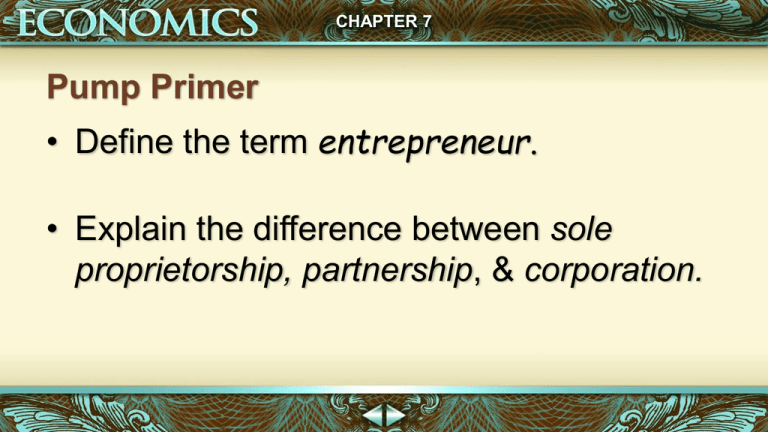Business Ownership: Sole Proprietorship, Partnership, Corporation
advertisement

CHAPTER 7 Pump Primer • Define the term entrepreneur. • Explain the difference between sole proprietorship, partnership, & corporation. CHAPTER 7 Forms of Business Ownership CHAPTER 7 Objectives: • Define entrepreneur, sole proprietorship, partnership, & corporation • Compare the advantage and disadvantages of organizing a business as a corporation, partnership, or sole proprietorship. • Explain limited liability. • Describe the Scriptural principles that apply to Christians involvement in partnerships. • Define and describe two types of corporation • Explain the significance of stock to a corporation. • Give examples of laws and regulations that affect how corporations and other forms of businesses are formed and operate. CHAPTER 7 Biblical Integration: • In order for a Christian entrepreneur to be successful in God's eyes, they must be diligent in all areas of their business. CHAPTER 7 Forms of Business Ownership • Sole proprietorship • Partnership • Corporation p. 128 CHAPTER 7 pp. 129-131 Sole Proprietorship • One owner • Most popular form of business ownership CHAPTER 7 pp. 129-131 Sole Proprietorship • Advantages: • • • • • freedom to enter and exit the market easily freedom from outside control freedom to retain information freedom from paying excessive taxes freedom from being an employee CHAPTER 7 Sole Proprietorship • Disadvantages: • • • • unlimited personal financial liability limited management and employee skills limited life limited availability of money pp. 129-131 CHAPTER 7 pp. 131-135 Partnership • Business enterprise with two or more owners • Least popular form of business ownership CHAPTER 7 Partnership • Questions: • Who are the partners? • What is each partner responsible to do? • How are profits to be divided? pp. 131-135 CHAPTER 7 Partnership • Questions: • How may a partner withdraw from the partnership? • How can the partnership be dissolved? pp. 131-135 CHAPTER 7 pp. 131-135 Partnership • Advantages: • • • • greater management skills greater retention of competent employees greater sources of financing ease of formation and freedom to manage CHAPTER 7 Partnership • Disadvantages: • unlimited personal financial liability • uncertain life • conflicts between partners pp. 131-135 CHAPTER 7 Partnership • Limited partnerships • at least one general partner • unlimited personal financial liability • makes most business decisions pp. 131-135 CHAPTER 7 Partnership • Limited partnerships • at least one limited partner • shares in profits • no management responsibilities • personal financial liability limited to the amount of his investment pp. 131-135 CHAPTER 7 pp. 131-135 Partnership • Scripture and partnerships • “unequal yoking” • surety • act of becoming security for or pledging to undertake another’s debt CHAPTER 7 pp. 135-140 Incorporation • In a corporation, the business is its own organization, independent of and separate from the owners • separate entity CHAPTER 7 pp. 135-140 Incorporation • Types of Corporations • private corporations: owned by private citizens • public corporations: owned by the general public and managed by the government • TVA, Amtrak CHAPTER 7 Incorporation • Ownership of a corporation • buying shares of stock pp. 135-140 CHAPTER 7 pp. 135-140 Incorporation • Advantages • limited personal financial liability of stockholders • experienced management and specialized employees CHAPTER 7 Incorporation • Advantages • continuous life • ease in raising financial capital pp. 135-140 CHAPTER 7 Incorporation • Disadvantages • • • • • higher taxes greater governmental regulation lack of secrecy impersonality rigidity pp. 135-140 CHAPTER 7 Other Types • S Corporation • Limited Liability Company (LLC) pp. 135-140 CHAPTER 7 pp. 135-140 S Corporation • Profits and losses are not taxed at the corporate level • Earnings are reported on the owner’s personal tax returns in much the same way as sole proprietorships and partnerships. • Limited to one class of stock and shareholders are limited in number and by U.S. residency. • Limited liability • Easier to raise capital and to transfer ownership • No corporate taxes, but have regulations just like a corporation. BUSINESS ABBREVIATIONS • • • • • • Ltd. (Limited Liability)* PC (Professional Corporation)* LLC (limited liability Company)* SA (Anonymous Society)* p.l.c. (Publicly Limited Company)* Inc. (Incorporation)* * These abbreviations reflect the legal separation of owners and the corporations. • Corp. (Corporation) • Co. (Company) ACTIVITY 1 • Break-up into groups of two or three. • Look over the list of companies and place them into the correct category of business types. ACTIVITY 2 Using your textbook and lecture notes complete the chart with your partner(s). • Define the term, then list all of the advantages and disadvantages for each form of business.







